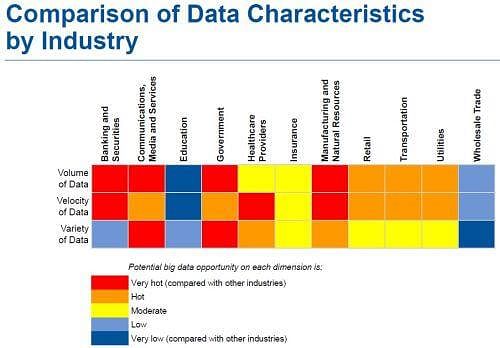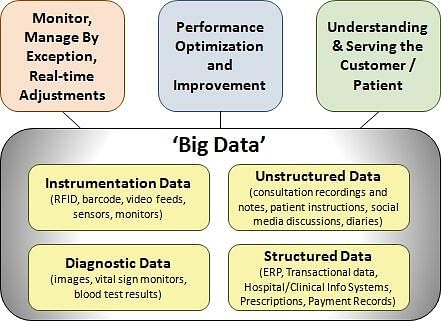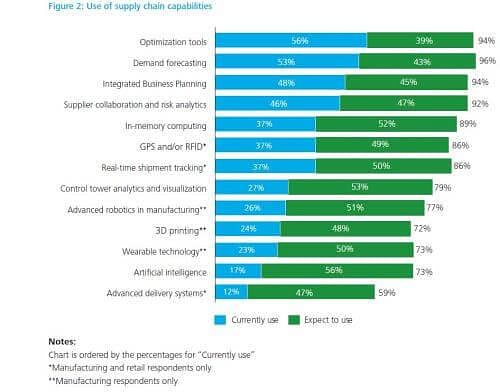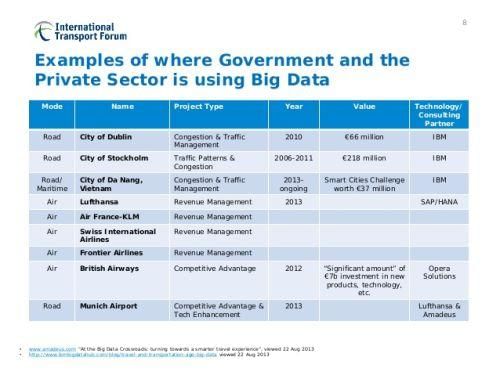Industry influencers, academicians, and other prominent stakeholders certainly agree that Big Data has become a big game-changer in most, if not all, types of modern industries over the last few years. As Big Data continues to permeate our day-to-day lives, there has been a significant shift of focus from the hype surrounding it to finding real value in its use.
While understanding the value of Big Data continues to remain a challenge, other practical challenges, including funding and return on investment and skills, continue to remain at the forefront for several different industries that are adopting Big Data. With that said, according to Research and Market reports, the global Big Data market size is expected to reach USD 268.4 billion by 2026.
Generally, most organizations have several goals for adopting Big Data projects. While the primary goal for most organizations is to enhance customer experience, other goals include cost reduction, better-targeted marketing, and making existing processes more efficient. In recent times, data breaches have also made enhanced security an important goal that Big Data projects seek to incorporate. More importantly, however, where do you stand when it comes to Big Data? You will very likely find that you are either:
- Trying to decide whether there is true value in Big Data or not.
- Evaluating the size of the market opportunity.
- Developing new services and products that will utilize Big Data.
- Already using Big Data solutions. Repositioning existing services and products to utilize Big Data, or
- Already utilizing Big Data solutions.
With this in mind, having a bird’s eye view of Big Data and its application in different industries will help you better appreciate what your role is or what it is likely to be in the future, in your industry or across various industries.

Source: Presented at Everis by Wilson Lucas (note that the diagram shows potential Big Data opportunities)
Here is the list of the top 14 industries using big data applications:
- Banking and Securities
- Communications, Media and Entertainment
- Healthcare Providers
- Education
- Manufacturing and Natural Resources
- Government
- Insurance
- Retail and Wholesale trade
- Transportation
- Energy and Utilities
- Big Data & Auto Driving Car
- Big Data in IoT
- Big Data in Marketing
- Big Data in Business Insights
In this article we will examine how the above-listed ten industry verticals are using Big Data, industry-specific challenges that these industries face, and how Big Data solves these challenges.
1. Banking and Securities
Industry-specific Big Data Challenges
A study of 16 projects in 10 top investment and retail banks shows that the challenges in this industry include: securities fraud early warning, tick analytics, card fraud detection, archival of audit trails, enterprise credit risk reporting, trade visibility, customer data transformation, social analytics for trading, IT operations analytics, and IT policy compliance analytics, among others.
Applications of Big Data in the Banking and Securities Industry
The Securities Exchange Commission (SEC) is using Big Data to monitor financial market activity. They are currently using network analytics and natural language processors to catch illegal trading activity in the financial markets.
Retail traders, Big banks, hedge funds, and other so-called ‘big boys’ in the financial markets use Big Data for trade analytics used in high-frequency trading, pre-trade decision-support analytics, sentiment measurement, Predictive Analytics, etc.
This industry also heavily relies on Big Data for risk analytics, including; anti-money laundering, demand enterprise risk management, “Know Your Customer,” and fraud mitigation.
Big Data providers are specific to this industry includes 1010data, Panopticon Software, Streambase Systems, Nice Actimize, and Quartet FS.
Industry-specific Big Data Challenges
Since consumers expect rich media on-demand in different formats and a variety of devices, some Big Data challenges in the communications, media, and entertainment industry include:
- Collecting, analyzing, and utilizing consumer insights
- Leveraging mobile and social media content
- Understanding patterns of real-time, media content usage
Applications of Big Data in the Communications, Media and Entertainment Industry
Organizations in this industry simultaneously analyze customer data along with behavioral data to create detailed customer profiles that can be used to:
- Create content for different target audiences
- Recommend content on demand
- Measure content performance
A case in point is the Wimbledon Championships (YouTube Video) that leverages Big Data to deliver detailed sentiment analysis on the tennis matches to TV, mobile, and web users in real-time.
Spotify, an on-demand music service, uses Hadoop Big Data analytics, to collect data from its millions of users worldwide and then uses the analyzed data to give informed music recommendations to individual users.
Amazon Prime, which is driven to provide a great customer experience by offering video, music, and Kindle books in a one-stop-shop, also heavily utilizes Big Data.
Big Data Providers in this industry include Infochimps, Splunk, Pervasive Software, and Visible Measures.
3. Healthcare Providers
Industry-specific Big Data Challenges
The healthcare sector has access to huge amounts of data but has been plagued by failures in utilizing the data to curb the cost of rising healthcare and by inefficient systems that stifle faster and better healthcare benefits across the board.
This is mainly because electronic data is unavailable, inadequate, or unusable. Additionally, the healthcare databases that hold health-related information have made it difficult to link data that can show patterns useful in the medical field.

Source: Big Data in the Healthcare Sector Revolutionizing the Management of Laborious Tasks
Other challenges related to Big Data include the exclusion of patients from the decision-making process and the use of data from different readily available sensors.
Applications of Big Data in the Healthcare Sector
Some hospitals, like Beth Israel, are using data collected from a cell phone app, from millions of patients, to allow doctors to use evidence-based medicine as opposed to administering several medical/lab tests to all patients who go to the hospital. A battery of tests can be efficient, but it can also be expensive and usually ineffective.
Free public health data and Google Maps have been used by the University of Florida to create visual data that allows for faster identification and efficient analysis of healthcare information, used in tracking the spread of chronic disease. Obamacare has also utilized Big Data in a variety of ways. Big Data Providers in this industry include Recombinant Data, Humedica, Explorys, and Cerner.
Big Data Students Also Enroll In
Big Data Hadoop and Spark Developer Free Course | MongoDB Developer and Administrator Free Course | Apache Spark Free Course | PySpark Free Course | Hadoop Free Course Apache Spark Data Analytics Free Course
4. Education
Industry-specific Big Data Challenges
From a technical point of view, a significant challenge in the education industry is to incorporate Big Data from different sources and vendors and to utilize it on platforms that were not designed for the varying data.
From a practical point of view, staff and institutions have to learn new data management and analysis tools.
On the technical side, there are challenges to integrating data from different sources on different platforms and from different vendors that were not designed to work with one another. Politically, issues of privacy and personal data protection associated with Big Data used for educational purposes is a challenge.
Applications of Big Data in Education
Big data is used quite significantly in higher education. For example, The University of Tasmania. An Australian university with over 26000 students has deployed a Learning and Management System that tracks, among other things, when a student logs onto the system, how much time is spent on different pages in the system, as well as the overall progress of a student over time.
In a different use case of the use of Big Data in education, it is also used to measure teacher’s effectiveness to ensure a pleasant experience for both students and teachers. Teacher’s performance can be fine-tuned and measured against student numbers, subject matter, student demographics, student aspirations, behavioral classification, and several other variables.
On a governmental level, the Office of Educational Technology in the U. S. Department of Education is using Big Data to develop analytics to help correct course students who are going astray while using online Big Data certification courses. Click patterns are also being used to detect boredom.
Big Data Providers in this industry include Knewton and Carnegie Learning and MyFit/Naviance.
5. Manufacturing and Natural Resources
Industry-specific Big Data Challenges
Increasing demand for natural resources, including oil, agricultural products, minerals, gas, metals, and so on, has led to an increase in the volume, complexity, and velocity of data that is a challenge to handle.
Similarly, large volumes of data from the manufacturing industry are untapped. The underutilization of this information prevents the improved quality of products, energy efficiency, reliability, and better profit margins.
Applications of Big Data in Manufacturing and Natural Resources
In the natural resources industry, Big Data allows for predictive modeling to support decision making that has been utilized for ingesting and integrating large amounts of data from geospatial data, graphical data, text, and temporal data. Areas of interest where this has been used include; seismic interpretation and reservoir characterization.
Big data has also been used in solving today’s manufacturing challenges and to gain a competitive advantage, among other benefits.
In the graphic below, a study by Deloitte shows the use of supply chain capabilities from Big Data currently in use and their expected use in the future.

Source: Supply Chain Talent of the Future
Big Data Providers in this industry include CSC, Aspen Technology, Invensys, and Pentaho.
6. Government
Industry-specific Big Data Challenges
In governments, the most significant challenges are the integration and interoperability of Big Data across different government departments and affiliated organizations.
Applications of Big Data in Government
In public services, Big Data has an extensive range of applications, including energy exploration, financial market analysis, fraud detection, health-related research, and environmental protection.
Some more specific examples are as follows:
Big data is being used in the analysis of large amounts of social disability claims made to the Social Security Administration (SSA) that arrive in the form of unstructured data. The analytics are used to process medical information rapidly and efficiently for faster decision making and to detect suspicious or fraudulent claims.
The Food and Drug Administration (FDA) is using Big Data to detect and study patterns of food-related illnesses and diseases. This allows for a faster response, which has led to more rapid treatment and less death.
The Department of Homeland Security uses Big Data for several different use cases. Big data is analyzed from various government agencies and is used to protect the country.
Big Data Providers in this industry include Digital Reasoning, Socrata, and HP.
7. Insurance
Industry-specific Big Data Challenges
Lack of personalized services, lack of personalized pricing, and the lack of targeted services to new segments and specific market segments are some of the main challenges.
In a survey conducted by Marketforce challenges identified by professionals in the insurance industry include underutilization of data gathered by loss adjusters and a hunger for better insight.
Applications of Big Data in the Insurance Industry
Big data has been used in the industry to provide customer insights for transparent and simpler products, by analyzing and predicting customer behavior through data derived from social media, GPS-enabled devices, and CCTV footage. The Big Data also allows for better customer retention from insurance companies.
When it comes to claims management, predictive analytics from Big Data has been used to offer faster service since massive amounts of data can be analyzed mainly in the underwriting stage. Fraud detection has also been enhanced.
Through massive data from digital channels and social media, real-time monitoring of claims throughout the claims cycle has been used to provide insights.
Big Data Providers in this industry include Sprint, Qualcomm, Octo Telematics, The Climate Corp.
8. Retail and Wholesale trade
Industry-specific Big Data Challenges
From traditional brick and mortar retailers and wholesalers to current day e-commerce traders, the industry has gathered a lot of data over time. This data, derived from customer loyalty cards, POS scanners, RFID, etc. are not being used enough to improve customer experiences on the whole. Any changes and improvements made have been quite slow.
Applications of Big Data in the Retail and Wholesale Industry
Big data from customer loyalty data, POS, store inventory, local demographics data continues to be gathered by retail and wholesale stores.
In New York’s Big Show retail trade conference in 2014, companies like Microsoft, Cisco, and IBM pitched the need for the retail industry to utilize Big Data for analytics and other uses, including:
- Optimized staffing through data from shopping patterns, local events, and so on
- Reduced fraud
- Timely analysis of inventory
Social media use also has a lot of potential use and continues to be slowly but surely adopted, especially by brick and mortar stores. Social media is used for customer prospecting, customer retention, promotion of products, and more.
Big Data Providers in this industry include First Retail, First Insight, Fujitsu, Infor, Epicor, and Vistex.
9. Transportation
Industry-specific Big Data Challenges
In recent times, huge amounts of data from location-based social networks and high-speed data from telecoms have affected travel behavior. Regrettably, research to understand travel behavior has not progressed as quickly.
In most places, transport demand models are still based on poorly understood new social media structures.
Applications of Big Data in the Transportation Industry
Some applications of Big Data by governments, private organizations, and individuals include:
- Governments use of Big Data: traffic control, route planning, intelligent transport systems, congestion management (by predicting traffic conditions)
- Private-sector use of Big Data in transport: revenue management, technological enhancements, logistics and for competitive advantage (by consolidating shipments and optimizing freight movement)
- Individual use of Big Data includes route planning to save on fuel and time, for travel arrangements in tourism, etc.

Source: Using Big Data in the Transport Sector
Big Data Providers in this industry include Qualcomm and Manhattan Associates.
10. Energy and Utilities
Industry-specific Big Data Challenges
The image below shows some of the main challenges in the energy and utility industry.
Applications of Big Data in the Energy and Utility Industry
Smart meter readers allow data to be collected almost every 15 minutes as opposed to once a day with the old meter readers. This granular data is being used to analyze the consumption of utilities better, which allows for improved customer feedback and better control of utilities use.
In utility companies, the use of Big Data also allows for better asset and workforce management, which is useful for recognizing errors and correcting them as soon as possible before complete failure is experienced.
Big Data Providers in this industry include Alstom Siemens ABB and Cloudera.
Master the Big Data & Hadoop frameworks, leverage the functionality of AWS services, and use the database management tool with the Big Data Engineer Course.

11. Big Data & Auto Driving Car
Autonomous driving cars are an emerging technology that is being developed by automobile manufacturers and technology companies around the world. One of the key challenges in creating autonomous driving cars is managing the large amounts of data generated by sensors and cameras on the vehicles. Big data technologies are critical in helping to manage and analyze this data in real-time, allowing the cars to make decisions based on the data they collect.
Some of the ways that big data is being used in autonomous driving cars include:
- Sensor data analysis: Autonomous driving cars rely on a variety of sensors to collect data about their environment, including cameras, lidar, and radar sensors. Big data technologies are used to analyze this data and identify objects, obstacles, and other vehicles on the road.
- Real-time decision-making: Autonomous driving cars must be able to make decisions in real-time based on the data they collect. Big data technologies help to process this data quickly and accurately, allowing the cars to make informed decisions.
- Predictive maintenance: Big data technologies can also be used to monitor the performance of autonomous driving cars and predict when maintenance or repairs are needed.
12. Big Data in IoT
The Internet of Things (IoT) refers to the network of connected devices, sensors, and other objects that are used to collect data and communicate with each other. Big data technologies are critical in managing and analyzing the large amounts of data generated by these devices.
Some of the ways that big data is being used in IoT include:
- Sensor data analysis: IoT devices generate large amounts of sensor data that must be analyzed to provide insights and identify patterns. Big data technologies are used to process and analyze this data, providing insights that can be used to optimize processes and improve efficiency.
- Predictive maintenance: IoT devices can be used to monitor equipment and predict when maintenance or repairs are needed. Big data technologies can be used to analyze this data and identify patterns that can be used to optimize maintenance schedules.
- Real-time decision-making: IoT devices can be used to collect data in real-time, allowing for real-time decision-making based on this data. Big data technologies are used to process and analyze this data quickly and accurately, allowing for informed decisions.
13. Big Data in Marketing
Big data is also being used extensively in marketing to better understand consumer behavior and preferences. Some of the ways that big data is being used in marketing include:
- Customer segmentation: Big data technologies are used to analyze customer data and segment customers based on their behavior and preferences. This allows marketers to create more targeted and effective marketing campaigns.
- Personalization: Big data technologies can be used to analyze customer data and provide personalized recommendations and offers.
- Predictive analytics: Big data technologies can be used to analyze customer behavior and predict future trends and behaviors. This can be used to inform marketing strategies and improve the effectiveness of marketing campaigns.
14. Big Data in Business Insights
Big data is also being used extensively to provide insights into business operations and performance. Some of the ways that big data is being used in business insights include:
- Performance analytics: Big data technologies can be used to analyze performance data from various business operations, providing insights into efficiency and effectiveness.
- Predictive analytics: Big data technologies can be used to predict future trends and performance, allowing businesses to make informed decisions and adjust strategies accordingly.
- Risk management: Big data technologies can be used to identify and mitigate risks, providing businesses with a more complete view of potential threats and vulnerabilities.
Conclusion
Having gone through 10 industry verticals including how Big Data plays a role in these industries, here are a few key takeaways:
- There is substantial real spending on Big Data.
- To capitalize on Big Data opportunities, you need to:
- Familiarize yourself with and understand industry-specific challenges.
- Understand or know the data characteristics of each industry.
- Understand where spending is occurring.
- Match market needs with your own capabilities and solutions.
- Vertical industry expertise is key to utilizing Big Data effectively and efficiently.
If there’s anything you’d like to add, explore, or know, do feel free to comment below.
If you’re interested in becoming a Big Data expert then we have just the right guide for you. The Big Data Career Guide will give you insights into the most trending technologies, the top companies that are hiring, the skills required to jumpstart your career in the thriving field of Big Data, and offers you a personalized roadmap to becoming a successful Big Data expert. To know more enroll in our Data Engineering Certification Program.


